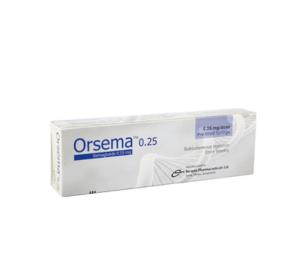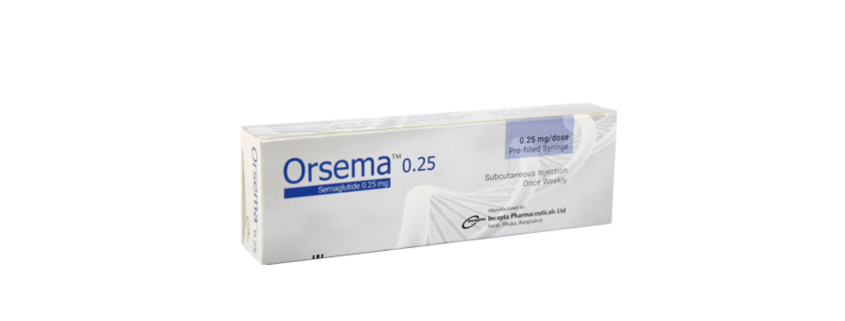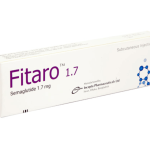Orsema(Semaglutide Injection)

Therapeutic Group: GLP-1 receptor agonist
Presentation
OrsemaTM 0.25 mg Injection: Each pre-filled syringe contains Semaglutide INN 0.25 mg in 0.188 ml solution for injection.
OrsemaTM 0.50 mg Injection: Each pre-filled syringe contains Semaglutide INN 0.50 mg in 0.375 ml solution for injection.
Description
Semaglutide is a GLP-1 analogue with 94% sequence as same as to human GLP-1. Semaglutide acts as a GLP-1 receptor agonist that selectively binds to and activates the GLP-1 receptor. Semaglutide reduces blood glucose in a glucose dependent manner by simulating insulin secretion and lowering glucagon secretion when blood glucose is high. The mechanism of blood glucose lowering also involves a minor delay in gastric emptying. During hypoglycemia, Semaglutide diminishes insulin secretion and does not impair glucagon secretion. Semaglutide reduces body weight and body fat mass by an overall reduced appetite.
Indications
• An adjunct to diet and exercise to improve glycemic control in adults with type 2 diabetes mellitus
• To reduce the risk of major adverse cardiovascular events in adults with type 2 diabetes mellitus and established cardiovascular disease
Dosage & Administration
The starting dose is 0.25 mg Semaglutide once weekly. After 4 weeks the dose should be increased to 0.5 mg once weekly. After at least 4 weeks with a dose of 0.5 mg once weekly, the dose can be increased to 1 mg once weekly to further improve glycemic control. Weekly doses higher than 1 mg are not recommended. Semaglutide is to be administered once weekly at any time of the day with or without meals. Semaglutide is to be injected subcutaneously in the abdomen, thigh or in upper arm. The injection site can be changed without dose adjustment. Semaglutide should not be administered intravenously or intramuscularly. The day of weekly administration can be changed if necessary as long as the time between two doses is at least 3 days (>72 hours). After selecting a new dosing day, once weekly dosing should be continued.
Precautions
Diabetic ketoacidosis: Semaglutide should not be used in type 1 diabetes mellitus or for the treatment of diabetic ketoacidosis.
Pancreatitis: Semaglutide should be discontinued promptly if pancreatitis is suspected and it should not be restart if pancreatitis is confirmed.
Diabetic Retinopathy: Patient with diabetic retinopathy should be monitored.
Use in Pregnancy & Lactation
Semaglutide should not be used during pregnancy. If a patient wishes to become pregnant Semaglutide should be discontinued at least 2 months before a planned pregnancy. As a risk to a breast-fed child cannot be excluded, Semaglutide should not be used during breast-feeding.
Drug Interaction
Semaglutide delays gastric emptying and has the potential to impact the rate of absorption of concomitantly administered oral medicinal products. Semaglutide should be used with caution in patients receiving oral medicinal products that require rapid gastrointestinal absorption.
Over Dose
Overdose of up to 4 mg in a single dose and up to 4 mg in a week have been reported in clinical trials. The most commonly reported adverse reaction was nausea. There is no specific antidote for overdose with Semaglutide. In the event of overdose appropriate supportive treatment should be initiated according to the patients clinical sign and symptoms.
Storage
Store at 2 C to 8 C (in a refrigerator). Do not freeze. Keep out of reach of children.
Commercial Pack
OrsemaTM 0.25 mg Injection: Each box contains 1 pre-filled syringe of Semaglutide 0.25 mg Injection.
OrsemaTM 0.50 mg Injection: Each box contains 1 pre-filled syringe of Semaglutide 0.50 mg Injection.



